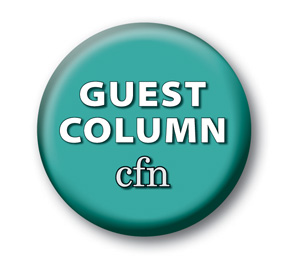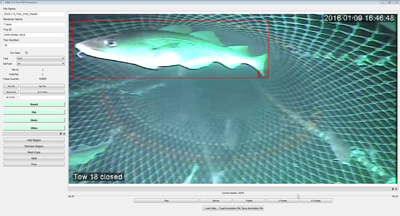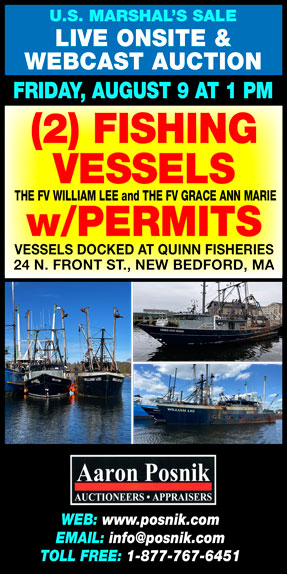Dr. Kevin Stokesbury is about to turn the world of fishery stock surveys on its head.
Fishermen have long maintained the NMFS stock assessment for Atlantic cod is out of touch with reality. Commercial boats fishing for healthy stocks such as pollock and haddock are finding codfish so plentiful they can’t keep them out of their nets, while the NMFS stock survey continues to turn up low numbers of cod.
 Right now, this disparity between scientific assessment and commercial real-life experience continues to increase the distance between fishermen and scientists.
Right now, this disparity between scientific assessment and commercial real-life experience continues to increase the distance between fishermen and scientists.
Why are their experiences so different?
NMFS scientists survey codfish stock using a stratified random design of 20-minute tows twice a year. This is radically different from the way commercial fishermen see the population.
Fishermen target schools of codfish in specific locations. After all, they wouldn’t make much money just throwing their trawls in the water randomly. More importantly, scientific studies have shown that codfish populations tend to aggregate, or bunch up, when they are under stress.
This makes it even more likely that a random survey design will miss these large concentrations of fish.
Because of this disconnect, it is clear that another type of stock survey is needed, one that can efficiently count and map the population geographically instead of randomly sampling the stock.
This is exactly what led Stokesbury and his research team at UMass Dartmouth to design a new system for surveying Atlantic cod.
I recently visited his lab in Dartmouth and got a first-hand look at the system his team has been developing for the past three years in collaboration with fishermen, the New England Fisheries Science Center (NEFSC), and the Massachusetts Div. of Marine Fisheries (MDMF).
Stokesbury’s team mounts high-resolution cameras on commercial trawls and records the number of groundfish in real-time passing through the gear.
The resulting video survey system can rapidly map large areas and count fish stocks using digital technology.
Stockesbury’s overall goal: to vastly increase the amount of information on fishery stocks by covering more sea floor area without killing more fish.

Fig 1. Cameras and lights mounted on polyethylene cylinder in codend.
How it works
The system mounts video cameras in the codend of commercial trawl gear, feeds the live video to DVRs for storage, and then runs computer software to process the captured data.
The data gathering portion of the system can be installed on any commercial trawler and its gear. Cameras and lights are mounted on a polyethylene cylinder in the codend (see Figure 1), live video feed is carried via cable up to the wheelhouse where HD video of fish passing through the gear can be viewed, and the video is stored on DVR.
Later, on shore, the post-processing stage of the system uses computer software to analyze the stored video and location data. The software sorts and counts the fish while it maps that data against locations on the ocean bottom (see Figure 2).
Because it is fully functional with the codend open or closed, Stokesbury’s system can survey using open codend tows for long distances without the need to haul back or kill any fish, and use closed codend tows to sample fish when necessary.
With the codend open, the fish pass through the trawl unharmed. In this mode, the system can “mow the lawn” for long periods and cover a large survey area instead of just sampling a small portion.
Alternatively, with the codend closed, surveyors can periodically catch and examine sample fish stock. Coupled with the ability to separate processing and analysis from the real-time work of surveying at sea, this flexibility has radically increased the value of the system as a fishery stock survey tool.

Fig 2. Post-processing software counting fish passing through trawl.
Collaboration is key
Based on his ten years of work with the scallop industry, Stokesbury realized early-on that his relationship with fisherman was critical to the development of the system.
For example, the camera frame had to be sewn into the codend without impacting the trawl’s ability to catch groundfish (see Figure 3).
At the same time, the gear’s ability to catch fish could not impede the system’s ability to count the fish.
Balancing these two requirements demanded a close working relationship between scientists and fishermen.
In another instance, after fishermen had tuned the trawl to catch fish, researchers found that the mud cloud created by the net itself was obscuring the view of cameras. Fishermen responded by tightening the belly of trawl thereby lifting the net slightly off the bottom and eliminated the cloud of mud.
Stokesbury points to this and other examples of customization that could never have been accomplished without a close partnership between fishermen and researchers.

Fig 3. Camera and light frame sewn into codend. (Graphics courtesy of Kevin Stokesbury/UMass Dartmouth)
Early results
Stokesbury’s team has been developing this system as a collaborative research program since 2013 and is about to launch its first official survey this coming November.
Up to this point, the system has been field tested surveying portions of Georges Banks and the Gulf of Maine, and has collected over 200 hours of video.
Two types of trawls have been used, one for yellowtail flounder and one for cod.
Even in testing, the system has already shown its potential for positive impact.
Stokesbury’s team ran a pilot survey for Atlantic cod in January 2016 on Stellwagen Bank. The survey featured eight closed and eleven open codend tows, covered 19 hours of sea bottom, and collected roughly 80 kilometers of video in just four days.
This was significantly faster and produced a richer set of data than the most recent NMFS survey, which featured 62 tows and covered 21 hours of sea floor over the period of several weeks.
But the data collected was the more significant result.
Stokesbury’s pilot survey swept a small area of just 300 sq kilometers, and using the data collected, the team produced a biomass estimate of 513 metric tons of Atlantic cod.
That estimate represents a shocking 23% of the NMFS total stock estimate of 2,230 metric tons in just 0.6% of the area for the Gulf of Maine – a miniscule portion of the overall area.
In other words, Stokesbury’s pilot survey has already turned up a whole lot more codfish than the NMFS stock assessment shows.
Impact
There is no question in my mind that Stokesbury’s system changes the game for both fishermen and scientists.
It is dramatically more efficient and can cover more area than current stock survey methods, can be operated non-destructively, delivers accurate digital data on the density and location of fish stock, and can be used on commercially competitive fishing gear.
After seeing this system, I am encouraged about the future of managing groundfish stocks for the first time in many years.
Stokesbury’s system has the potential of accurately portraying the true state of recovery for the Atlantic cod. It also stands to significantly increase collaboration between scientists and fishermen, and restore the trust that is essential to restoring the fishery.
Paul David Callahan is a former herring seiner, now author. Door in Dark Water, his book about fishing in the Gulf of Maine in the 70s, is available at Amazon.com. He can be reached at <pcallahan@coonianresearch.com>.
 To get the more great content like this, you’ll need the October 2016 issue of Commercial Fisheries News – please choose from the following options:
To get the more great content like this, you’ll need the October 2016 issue of Commercial Fisheries News – please choose from the following options:
BUY a Single PRINT edition of CFN that is delivered by MAIL. PRINT EDITION
Quickly enjoy ONLINE access with our Hi-DEF flip-book. PURCHASE ONLINE EDITION
(Read online flip-book immediately with purchased access key and download a copy for yourself to keep. Not sure if it works for you? Try a FREE SAMPLE HERE.)
SAVE BIG when you SUBSCRIBE!







